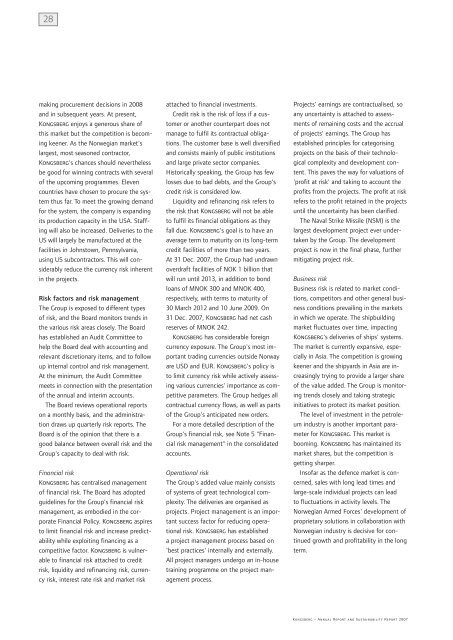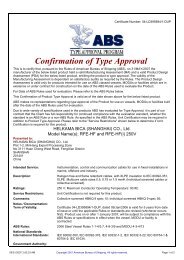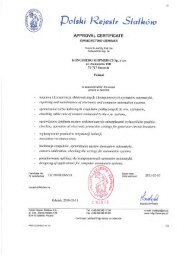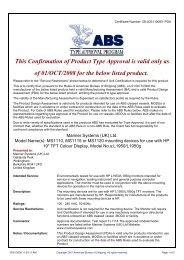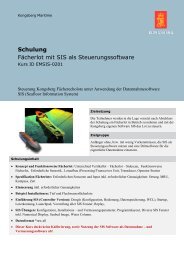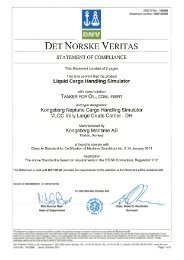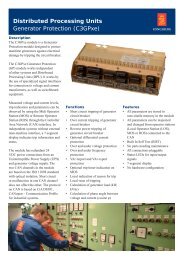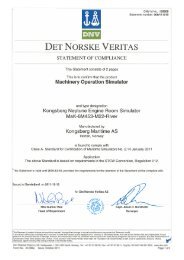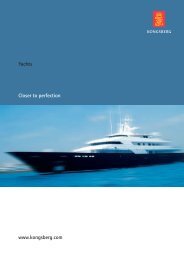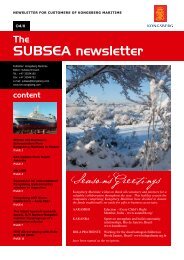Report - Kongsberg Gruppen 2007 - Kongsberg Maritime ...
Report - Kongsberg Gruppen 2007 - Kongsberg Maritime ...
Report - Kongsberg Gruppen 2007 - Kongsberg Maritime ...
You also want an ePaper? Increase the reach of your titles
YUMPU automatically turns print PDFs into web optimized ePapers that Google loves.
28<br />
making procurement decisions in 2008<br />
and in subsequent years. At present,<br />
<strong>Kongsberg</strong> enjoys a generous share of<br />
this market but the competition is becom -<br />
ing keener. As the Norwegian market's<br />
largest, most seasoned contractor,<br />
<strong>Kongsberg</strong>'s chances should nevertheless<br />
be good for winning contracts with several<br />
of the upcoming programmes. Eleven<br />
coun tries have chosen to procure the sys -<br />
tem thus far. To meet the growing demand<br />
for the system, the company is expanding<br />
its production capacity in the USA. Staf f -<br />
ing will also be increased. Deliveries to the<br />
US will largely be manufactured at the<br />
facil ities in Johnstown, Pennsylvania,<br />
using US subcontractors. This will con -<br />
sider ably reduce the currency risk inherent<br />
in the projects.<br />
Risk factors and risk management<br />
The Group is exposed to different types<br />
of risk, and the Board monitors trends in<br />
the various risk areas closely. The Board<br />
has established an Audit Committee to<br />
help the Board deal with accounting and<br />
rele vant discretionary items, and to follow<br />
up internal control and risk management.<br />
At the minimum, the Audit Committee<br />
meets in connection with the presentation<br />
of the annual and interim accounts.<br />
The Board reviews operational reports<br />
on a monthly basis, and the administra -<br />
tion draws up quarterly risk reports. The<br />
Board is of the opinion that there is a<br />
good balance between overall risk and the<br />
Group's capacity to deal with risk.<br />
Financial risk<br />
<strong>Kongsberg</strong> has centralised management<br />
of financial risk. The Board has adopted<br />
guidelines for the Group's financial risk<br />
management, as embodied in the cor -<br />
porate Financial Policy. <strong>Kongsberg</strong> aspires<br />
to limit financial risk and increase predict -<br />
ability while exploiting financing as a<br />
competitive factor. <strong>Kongsberg</strong> is vulner -<br />
able to financial risk attached to credit<br />
risk, liquidity and refinancing risk, cur ren -<br />
cy risk, interest rate risk and market risk<br />
attached to financial investments.<br />
Credit risk is the risk of loss if a cus -<br />
tomer or another counterpart does not<br />
manage to fulfil its contractual obliga -<br />
tions. The customer base is well diversified<br />
and con sists mainly of public institutions<br />
and large private sector companies.<br />
Historically speaking, the Group has few<br />
losses due to bad debts, and the Group's<br />
credit risk is considered low.<br />
Liquidity and refinancing risk refers to<br />
the risk that <strong>Kongsberg</strong> will not be able<br />
to fulfil its financial obligations as they<br />
fall due. <strong>Kongsberg</strong>'s goal is to have an<br />
average term to maturity on its long-term<br />
credit facilities of more than two years.<br />
At 31 Dec. <strong>2007</strong>, the Group had undrawn<br />
over draft facilities of NOK 1 billion that<br />
will run until 2013, in addition to bond<br />
loans of MNOK 300 and MNOK 400,<br />
respectively, with terms to maturity of<br />
30 March 2012 and 10 June 2009. On<br />
31 Dec. <strong>2007</strong>, <strong>Kongsberg</strong> had net cash<br />
reserves of MNOK 242.<br />
<strong>Kongsberg</strong> has considerable foreign<br />
cur rency exposure. The Group's most im -<br />
portant trading currencies outside Norway<br />
are USD and EUR. <strong>Kongsberg</strong>'s policy is<br />
to limit currency risk while actively asses s -<br />
ing various currencies' importance as com -<br />
petitive parameters. The Group hedges all<br />
contractual currency flows, as well as parts<br />
of the Group's anticipated new orders.<br />
For a more detailed description of the<br />
Group's financial risk, see Note 5 "Finan -<br />
cial risk management" in the consolidated<br />
accounts.<br />
Operational risk<br />
The Group's added value mainly consists<br />
of systems of great technological com -<br />
plexi ty. The deliveries are organised as<br />
projects. Project management is an im por -<br />
tant success factor for reducing opera -<br />
tional risk. <strong>Kongsberg</strong> has established<br />
a project management process based on<br />
'best practices' internally and externally.<br />
All project managers undergo an in-house<br />
training programme on the project man -<br />
agement process.<br />
Projects' earnings are contractualised, so<br />
any uncertainty is attached to assess -<br />
ments of remaining costs and the accrual<br />
of projects' earnings. The Group has<br />
estab lished principles for categorising<br />
proj ects on the basis of their techno lo -<br />
gical complexity and development con -<br />
tent. This paves the way for valuations of<br />
'profit at risk' and taking to account the<br />
profits from the projects. The profit at risk<br />
refers to the profit retained in the projects<br />
until the uncertainty has been clarified.<br />
The Naval Strike Missile (NSM) is the<br />
largest development project ever under -<br />
taken by the Group. The development<br />
project is now in the final phase, further<br />
mitigating project risk.<br />
Business risk<br />
Business risk is related to market condi -<br />
tions, competitors and other general busi -<br />
ness conditions prevailing in the markets<br />
in which we operate. The shipbuilding<br />
market fluctuates over time, impacting<br />
<strong>Kongsberg</strong>'s deliveries of ships' systems.<br />
The market is currently expansive, espe -<br />
cial ly in Asia. The competition is growing<br />
keener and the shipyards in Asia are in -<br />
creasingly trying to provide a larger share<br />
of the value added. The Group is monitor -<br />
ing trends closely and taking strategic<br />
initiatives to protect its market position.<br />
The level of investment in the petro le -<br />
um industry is another important para -<br />
meter for <strong>Kongsberg</strong>. This market is<br />
booming. <strong>Kongsberg</strong> has maintained its<br />
market shares, but the competition is<br />
getting sharper.<br />
Insofar as the defence market is con -<br />
cern ed, sales with long lead times and<br />
large-scale individual projects can lead<br />
to fluctuations in activity levels. The<br />
Norwegian Armed Forces' development of<br />
pro prietary solutions in collaboration with<br />
Nor wegian industry is decisive for con -<br />
tinu ed growth and profitability in the long<br />
term.<br />
<strong>Kongsberg</strong> – Annual <strong>Report</strong> and Sustainability <strong>Report</strong> <strong>2007</strong>


